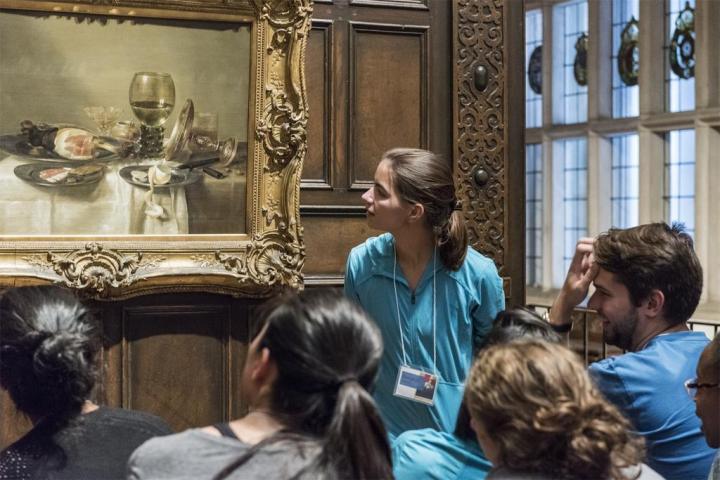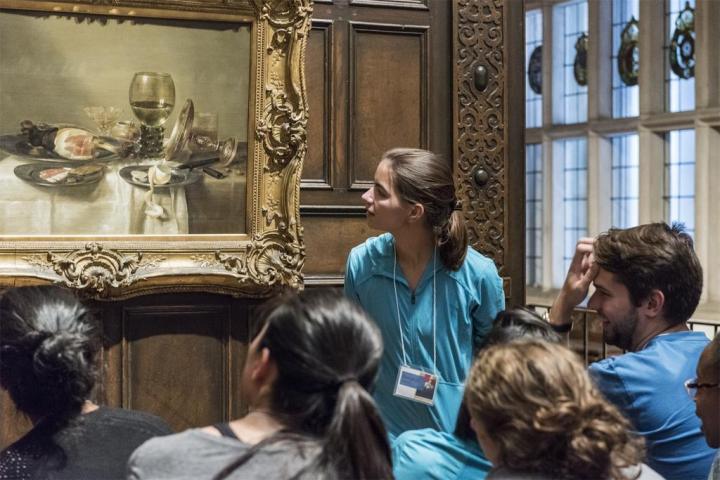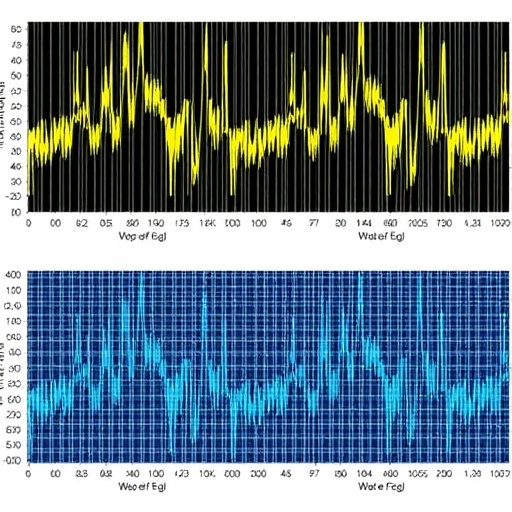
Credit: Penn Medicine
PHILADELPHIA — Observation skills are an essential component of any medical education, aiding doctors during patient exams and in making medical diagnoses, yet several studies have indicated inadequacies in this area among medical trainees and practicing physicians. In an effort to explore ways to improve these skills among medical students, researchers from Perelman School of Medicine at the University of Pennsylvania and Children's Hospital of Philadelphia (CHOP), in collaboration with educators at the Philadelphia Museum of Art, turned to the field of visual arts to examine if training in art observation, description, and interpretation could be applied to medical training.
In a study published this month in Ophthalmology, researchers drew from previous studies that suggested art observation could improve medical students' descriptive skills and applied formal research methods to evaluate extensive art training among first-year medical students. The team saw significant improvement in observational recognition skills among students who took an art observation course and demonstrated that art training alone – without a clinical component – could help teach medical students to become better clinical observers.
"The skills I learned studying fine arts in college are invaluable to me now as a physician. I saw the impact art education had on my approach to medicine, and I wanted to recreate that experience for others in the field," said the study's lead author, Jaclyn Gurwin, MD, an Ophthalmology resident in the Scheie Eye Institute at the University of Pennsylvania. "The results of this study are incredibly encouraging, showing that art observation training can improve medical and ophthalmological observational skills. We hope that the improved observational abilities from this training will translate to improved clinical effectiveness, empathy and, ultimately, will make better physicians."
Thirty-six first-year medical students were randomly assigned to take six, 1.5-hour art observation courses at the Philadelphia Museum of Art or to be a part of a control group that received no formal art observation training. The art sessions were taught by professional art educators using the "Artful Thinking" teaching approach, which emphasizes introspection and observation before interpretation. Instruction included sessions in front of works of art, group discussions, and training in visual arts vocabulary. The Artful Thinking approach also emphasizes lessons that encourage particular kinds of thinking such as creative questioning, reasoning, and perspective taking.
All 36 subjects completed an observation skills test before being divided into the randomized groups and then took the test again at the end of the course. The assessments included description testing and emotional recognition testing of retinal and facial disease photographs. Students who took the "Artful Thinking" course showed a significant improvement in their observational skills as compared to the control group.
In a post-study questionnaire, students who received the art training indicated that they had already begun to apply the skills used in the course in clinically meaningful ways as first-year medical students.
"After just one session, I found myself listening to a radiologist discuss the same principles we used to look at art when analyzing a CT scan," said one student. "Later I found our practice of creating narratives in the art class helped guide me when interacting with standardized patients."
The authors note that one common theme among trainees is that making accurate observations or diagnoses when presented with complex visual information can be challenging. The art observation training in the study provided a structured approach for first-year medical students, who have limited experience in navigating visually complex clinical situations.
"Art training could be helpful across many specialties, especially ones like ophthalmology, dermatology, and radiology, where diagnosis and treatments plans are based primarily on direct observation," said Gil Binenbaum, MD, MSCE, an associate professor of Ophthalmology in the Perelman School of Medicine, a pediatric eye surgeon in the division of Ophthalmology at CHOP, and senior author of the study.
Students who took the art training course also anecdotally demonstrated improvements in empathy and emotional recognition, such as noting emotions and sensations (i.e. pain or sadness) in works of art, test scores did not show a significant difference between the control group and the students who took the art course.
"I believe I've become more open-minded as a result of the course primarily because of the discussions we had as a group," said one study participant. "I'm not sure that improving my observational skills increased my ability to emphasize, but recognizing the validity of others' opinions certainly did."
The art training placed students in an environment where they were given the opportunity to listen and learn from their peers and hear multiple viewpoints about an unfamiliar subject matter that does not have a clear or correct answer. As the survey results indicated, this experience helped improve the students' ability to appreciate other people's opinions, a skill that could be applied to many small-group and clinical learning experiences.
Further studies will aim to address both a more sensitive measure for changes in emotional competency as well as the long-term effects of this training on overall clinical observational skills.
"It is incredibly encouraging to see that principles from a field, such as art, that can seem so vastly different from medicine, can be so successfully applied and utilized to help improve clinical skills and overall professional development for medical students," said Horace DeLisser, MD, associate dean for Diversity and Inclusion in the Perelman School of Medicine. "We look forward to continuing to see how these principals can be used long-term for medical trainees and practicing physicians."
Following the success of the study, The Perelman School of Medicine will be offering this Philadelphia Museum of Art course to first-year medical students during the 2017 fall semester.
###
Other co-authors of the study include Karen E. Revere, Suzannah Niepold, Barbara Basset, Rebecca Mitchell, and Stephanie Davidson.
Penn Medicine is one of the world's leading academic medical centers, dedicated to the related missions of medical education, biomedical research, and excellence in patient care. Penn Medicine consists of the Raymond and Ruth Perelman School of Medicine at the University of Pennsylvania (founded in 1765 as the nation's first medical school) and the University of Pennsylvania Health System, which together form a $6.7 billion enterprise.
The Perelman School of Medicine has been ranked among the top five medical schools in the United States for the past 20 years, according to U.S. News & World Report's survey of research-oriented medical schools. The School is consistently among the nation's top recipients of funding from the National Institutes of Health, with $392 million awarded in the 2016 fiscal year.
The University of Pennsylvania Health System's patient care facilities include: The Hospital of the University of Pennsylvania and Penn Presbyterian Medical Center — which are recognized as one of the nation's top "Honor Roll" hospitals by U.S. News & World Report — Chester County Hospital; Lancaster General Health; Penn Wissahickon Hospice; and Pennsylvania Hospital — the nation's first hospital, founded in 1751. Additional affiliated inpatient care facilities and services throughout the Philadelphia region include Good Shepherd Penn Partners, a partnership between Good Shepherd Rehabilitation Network and Penn Medicine.
Penn Medicine is committed to improving lives and health through a variety of community-based programs and activities. In fiscal year 2016, Penn Medicine provided $393 million to benefit our community.
Media Contact
Johanna Harvey
[email protected]
215-349-8062
@PennMedNews
http://www.uphs.upenn.edu/news/





